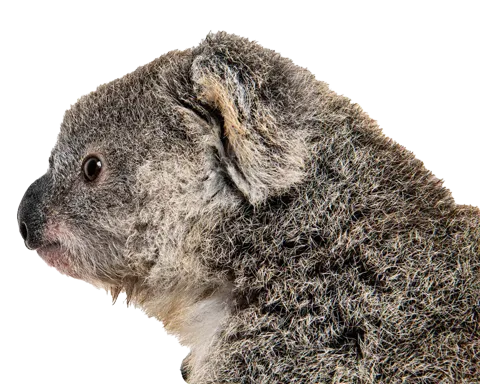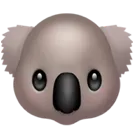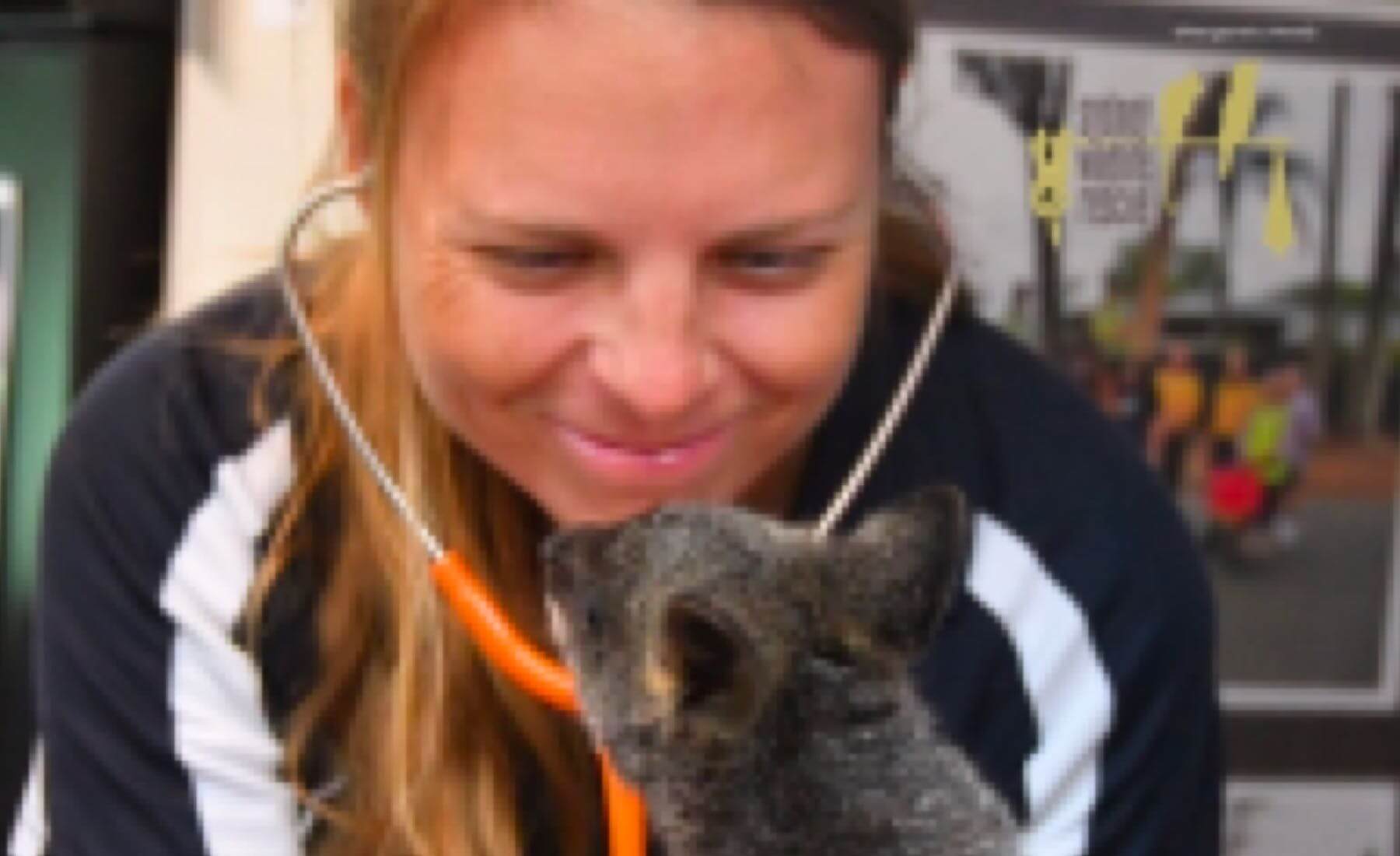
There is never a quiet day in the Mobile Care Unit. Our list of patients can vary from a 3g pygmy possum to a 20kg wallaby! Last week we started one day with a death adder and ended that day with a lace monitor. Every type of furry, feathery, spiny and scaly patient has been brought to see our volunteer vets – some even coming from as far afield as Lithgow!
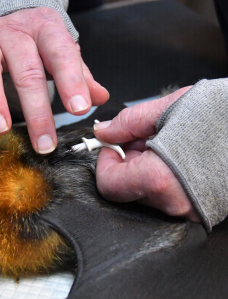
_Flying Fox being microchipped
_
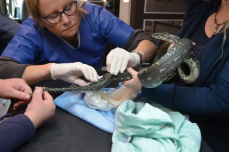
Microchipping a diamond python prior to release
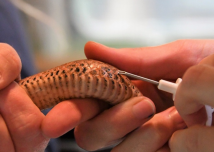
Death adder being chipped.
We have been microchipping many of our patients before release over the past few months. It is a useful tool for us as the microchip allows us to record if a particular patient is a “repeat offender” and whether or not their initial malady is a recurring problem. In the case of macropods, we can ascertain whether a patient was perhaps a handraised individual that has run into trouble in the wild. We can also scan roadkill for microchips to see if they happen to be a previous patient. Snakes are a particularly interesting animal to have microchipped as they are often relocated from unsuitable environments (wardrobes, toy- boxes, bathrooms and bbqs) back to the bush (but still within their home-range). As a general rule, rescuers will only move a snake if it is inside a person’s home or if it is in imminent danger (bailed up in the backyard by dogs or in a high-traffic area such as a shopping precinct). It is interesting to see that snakes will often re-surface fairly close to their original site of rescue – a bit like a homing pigeon. This is one of the reasons we relocate them within their home-range – to ensure that they do not put themselves into unnecessary danger trying to get back to their area of familiarity. A few of our reptilian patients that have been in care over winter or long-term get chipped to see if they return with the same issues as before. We had a water dragon patient with a fungal issue which was treated successfully and he was chipped before release. The members of the public were asked to keep a close eye on the colony.
Over the past few months we have had the pleasure of hosting some final year veterinary students from Sydney University. One of the Mobile Care Unit’s main objectives is to prepare future veterinarians for handling, assessing and treating wildlife of all species. Our volunteer vets - Dr Margot, Dr Lou and Dr Izi - are always very generous with their time and are happy to share their expertise with vet students in their final year of study. Interestingly, all the vet students we have hosted so far have had names starting with an A – Athena, Alex, Aislinn and soon Amy! Stephanie broke the pattern, though. On her last day in the van, Stephanie did a presentation to our vets on Reptile Analgesia which was very interesting and insightful. During their time with us in the van, the students have done everything from administering parenteral fluids to snakes and x-raying lace monitors to doing faecal floats and blood tests in wallabies and birds.
Being a teaching facility is one of the things we love most about providing this service to our community. One day these vet students will be in their own clinics and will already have a greater appreciation for wildlife and the importance of treating them with the same compassion and care as pets with owners.
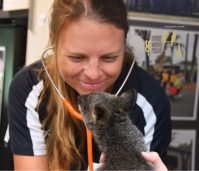
_Vet student Stephanie with a wallaby joey
_
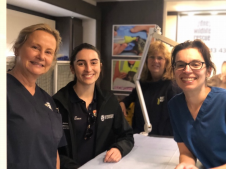
_Vet student Aislinn with Dr. Lou, Joan and Dr. Izi
_
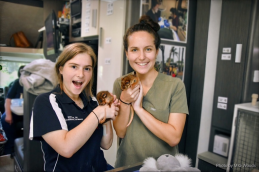
_Vet students Athena and Alex
_
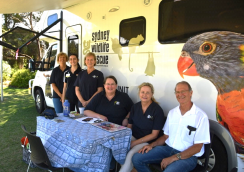
Aislinn with Joan, Dr. Margot, Susan, Dr.Lou and Dr. Derek Spielman who was visitng for the day
In April, we managed to secure a Vetscan blood machine for our vets to use in the van and the Zoetis/Vetscan team came to give us a tutorial on how to use it for serologic testing. Dr Derek Spielman was also present that morning during the training. Dr Spielman is a senior lecturer in veterinary Pathology at the University of Sydney and he is always available to give advice to our vets on histopathology etc.
Once a month, we are joined by Dr Kath Graham who is an ophthalmic veterinarian. Dr Kath treats patients with eye anomalies and provides advice to carers who bring in patients with temporary visual issues. This month Dr Kath has been treating a possum with cataracts, a wallaby with a penetrating eye injury and a lace monitor with a hyphaema. A hyphaema is a pooling of blood inside the anterior chamber of the eye (the space between the cornea and the iris). After a head trauma, the lace monitor had blood covering most of the iris and the pupil which was blocking its vision. Dr Kath examined the eye thoroughly using a slit-lamp and tested the eye pressure using rebound tonometry. She prescribed specific drops which will help to alleviate pain and inflammation while the hyphaema resolves.
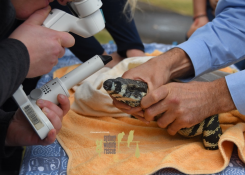
Dr Kath using a slit-lamp to examine the monitor’s eye
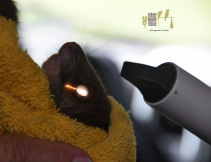
Dr Kath examining a possum’s eyes
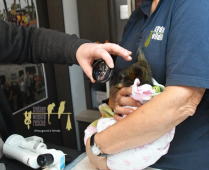
Examining a traumatic eye injury in a wallaby joey
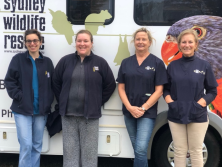
Dr Izi, Dr Kath, Dr Lou and Dr Margot
It is very advantageous to have a multitude of resources at our disposal. Our brilliant volunteer veterinarians are able to liaise with expert pathologists such as Dr Spielman, as well as the vets and staff at the Australian Registry of Wildlife Health. We are also very lucky to call on the incredible services of Fran Wilcox for physical rehabilitation and of course, Dr Kath Graham for ophthalmic advice. Our wild patients are very fortunate.
